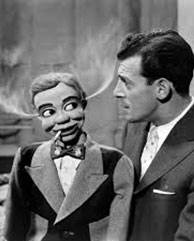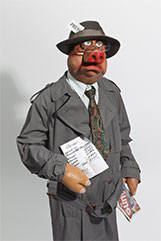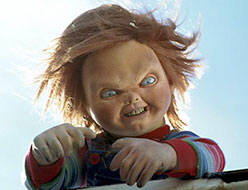
History
Others
Puppets

Are Puppets Just for Kids?
Puppet theatre was never meant to be solely entertainment for children. Theatre historian George Speaight, put the message across well. 'The puppet theatre has not always been a children's theatre, but has always been the theatre of the people'. With the adult satirical and social comment in, for example Punch and Judy, this comment is borne out. So why has the puppet been discarded into the child's toy box? By looking back at the stars of the early years of the small screen, it can be said that all the major television puppets at that time were aimed at the child. This perhaps reflects what was happening in our society at the time to the art of the puppet show. The likes of Punch and Judy had been on the decline for years, and were finding it very hard to find an audience for a sophisticated adult performance. With film and television becoming more popular, live arts such as puppetry suffered. As television progressed and became ever increasingly more competent, the public expected more than the jerky movements of Andy Pandy style marionettes. With technologically excellent productions from Gerry Anderson, his marionettes became minute puppet masterpieces. Although nostalgia goes a long way to explaining the popularity of Thunderbirds, it is apparent that this is not the one and only reason for the cult adult following. The puppetry itself is the major draw for adults who watch the show. No one can refute that Thunderbirds' charm originates from the audiences' delight in watching the imaginary puppet mini-universe. The escapism and relaxation that these shows can offer the viewer explains further the adult appeal for what is, after all, a children's programme.
The Gerry Anderson productions cleared the way in Britain for what has been coined as 'kidult' shows - programmes aimed at adults through children's viewing. The popular Pinky and Perky could be described as kidult, but it is the madcap muppets that truly fit this description. The emergence of the muppets on British television, first through Sesame Street and later The Muppet Show, elevated television puppets to a never before reached adult level. The multi-layered sketches, containing humour that could be read on many different levels, aided the adults' enjoyment. The muppet parodies of well known and loved adult shows, films and musical numbers appeal to children and grown-ups alike. The characters were easy for anybody to identify with, and as such it was simple to become immersed into the pure madcap enjoyment the muppets presented. The creations of Jim Henson have influenced generations of puppeteers, many following in his methods of puppetry. The marionette has fallen out of favour, to be replaced with Jim Henson style flexible and emotive puppets.
Puppet programmes today, with the increased level of technology, are often more complicated to produce than many other types of television shows. They can often cost more to make too, in both time and labour, than an equivalent production using live actors. Nowadays the use of puppetry is always chosen as an aid to the show, and in the case of series such as Spitting Image, one of the major attractions. With its sharp note of cynicism and crass fun poking at celebrities, Spitting Image ran for over a decade. It is a prime example of an adult series that would not have worked without the use of its caricatured latex puppet cast.
The myth that puppets are only children's entertainment does not stand up to scrutiny. The Muppet Show obtained very strong audience viewing figures, higher than any obtained by shows transmitted exclusively to children. Spitting Image on the other hand, in a similar manner to the 18th century satiric puppet theatre, was aimed totally at the adult, and never intended at any time as viewing for juniors. Also, it is very naive to believe that all puppets are appealing to children. The use of the puppet, especially ventriloquist's dummies, is a well-used plot device in horror tales. Considering how many people hold some fear for the puppet, it is perhaps strange that puppetry has become known as the art for the child. The fact that the clown, originally intended as innocent, is often thrown in with the puppet as scary, is in itself interesting. It is human nature to distrust and fear the non-human aspect of both clowns and puppets. Both are non-human in different ways, but both can be disconcerting. Mannequin style puppets can appear 'dead' when they are not in use, and when they do move it can appear that they are moving by themselves, perhaps with an evil secret agenda, the out of sight puppeteer being forgotten. It is perhaps this fear that harks back more than anything to the pagan rituals and black magic of early puppetry.
The apprehension and distrust the human condition can hold for the inanimate object that appears almost human may be illogical, but it is nevertheless a natural instinct. It is an instinct that horror producers love, and is an instinct that is never lost, whatever the age of the viewer. The devil doll Chucky from the film Child's Play is a perfect example of the way horror producers' prey on this basic fear. However, puppetry is even more important to the horror genre than simply a plot device. The complicated effects of today's spine chilling tales involve many different components, one of which is an advanced area of puppetry - animatronics. With the use of animatronics, the adult viewers can sometimes forget that they are watching a puppet. Often a combination of puppetry and computer animation is used to create an illusion that is as believable as the real thing. And this method is not just confined to horror. The portrayal during any live action drama of a nonhuman life form - be it a devil, an alien or fearsome animal - is often created with the aid of puppetry. So varied is this ancient tradition that all sorts of programmes, from pre-school television to spine chilling gore-fests can be brought to the screen.
The art of the puppet has an honourable history in the medium of satire and drama. It has never been intended solely as entertainment for the kiddies, and although pure adult puppetry does not often surface on the small screen, those that do capture the imagination of the audience in a way that live action cannot. Puppetry is an important aspect of screen entertainment, and today is viewed in a format that would have baffled the priests that created them centuries ago. The final words are to be left to George Speaight:
'It is, indeed, impressive to be able to record that this primitive form of theatre, which grew from priestly incantations in ancient temples, is now seen by millions around the world. But the essence of puppetry does not lie in numbers. The secret of this art is to be found in the magic when an inanimate figure creates an emotional contact with a human spectator. May this magic never die.'
The Press Pig From Spitting Image (Left)
Chucky From Child's Play (Above)
A Ventriloquist & His Dummy (Right)





This website is the copyright of Benjamin Burford-Jones 2014, except quotations and photographs used to illustrate various traditional and television puppets.
No material should be reproduced in any form whatsoever for purposes of commercial gain without obtaining the copyright holder’s express permission.
Herb the Owl | Alex the Droog | What is a Puppet | Watching With Mother | Gerry Anderson | Jim Hensons Muppets
From Satire to Sitcom | Are Puppets Just for Kids | About the Author and Links















